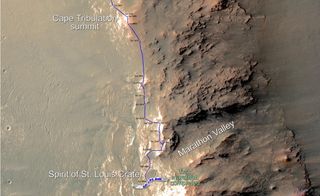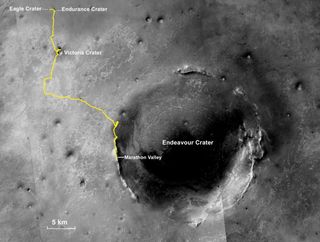
NASA's Opportunity rover has completed the first-ever Mars marathon, clocking in with a winning time of 11 years and 2 months.
The golf-cart-size Opportunity rover has now traveled 26.221 miles (42.198 kilometers) since touching down on the Red Planet on Jan. 24, 2004, NASA officials announced today (March 24). The length of a marathon race is 26.219 miles (42.195 km).
"This is the first time any human enterprise has exceeded the distance of a marathon on the surface of another world," John Callas, Opportunity project manager at NASA's Jet Propulsion Laboratory (JPL) in Pasadena, California, said in a statement. "A first time happens only once." [Inside Opportunity's Record-Setting Mars Marathon (Infographic)]

Opportunity reached the milestone with a 153-foot (46.5 meters) drive today that took it close to a location dubbed Marathon Valley, located on the rim of Endeavour Crater. The six-wheeled robot has been exploring the 14-mile-wide (22 km) crater's western rim since August 2011.
Opportunity adds to its off-world driving record with every turn of its wheels. Second place belongs to the Soviet Union's Lunokhod 2 rover, which covered 24.2 miles (39 km) on the moon back in 1973.
"This mission isn't about setting distance records, of course. It's about making scientific discoveries on Mars and inspiring future explorers to achieve even more," Steve Squyres, Opportunity principal investigator at Cornell University in Ithaca, New York, said in the same statement. "Still, running a marathon on Mars feels pretty cool."

Opportunity landed three weeks after its twin, Spirit, on a mission to search for signs of past water activity on Mars. Both rovers found plenty of such evidence, fundamentally reshaping scientists' understanding of Red Planet history, and the rovers then kept chugging along.
Get the Space.com Newsletter
Breaking space news, the latest updates on rocket launches, skywatching events and more!
Spirit stopped communicating with Earth after getting bogged down in some loose sand in 2010 and was declared dead a year later. Opportunity remains active, though it has been showing signs of its advanced age. The rover's robotic arm is arthritic, for example, and engineers recently installed a software upgrade to deal with a memory issue that had been afflicting Opportunity since late 2014.
Opportunity is currently studying a small crater called Spirit of St. Louis, which lies just west of Marathon Valley. NASA's Mars Reconnaissance Orbiter has spotted signs of clay minerals, an indication of a wet past environment, in Marathon Valley, and the rover team plans to check out these deposits soon.
Opportunity team members will hold a marathon-length relay race next week at JPL to celebrate the driving milestone, NASA officials said.
Follow Mike Wall on Twitter @michaeldwall and Google+. Follow us @Spacedotcom, Facebook or Google+. Originally published on Space.com.
Join our Space Forums to keep talking space on the latest missions, night sky and more! And if you have a news tip, correction or comment, let us know at: community@space.com.

Michael Wall is a Senior Space Writer with Space.com and joined the team in 2010. He primarily covers exoplanets, spaceflight and military space, but has been known to dabble in the space art beat. His book about the search for alien life, "Out There," was published on Nov. 13, 2018. Before becoming a science writer, Michael worked as a herpetologist and wildlife biologist. He has a Ph.D. in evolutionary biology from the University of Sydney, Australia, a bachelor's degree from the University of Arizona, and a graduate certificate in science writing from the University of California, Santa Cruz. To find out what his latest project is, you can follow Michael on Twitter.











